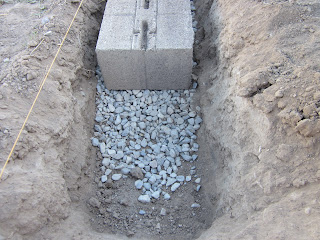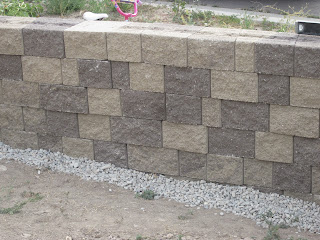First, we staked out where we wanted the wall to go. 1) for measuring purposes, 2) to make sure we kept working in a straight line. Also, We put the string at the height that we wanted the wall. When figuring out how many blocks you need, you will need to know both the length and the height of the wall.

Next, we dug the trenches. Take extra care to make sure that the bottom of the trench is level. We have super hard dirt, so we had to use a pick ax to dig.
Use the tamper to level out the gravel, then use a landscaping level to make sure that it really is level.
The trench should be dug deep enough that the block is buried a couple inches below the ground level, even though it is laid on top of a couple inches of gravel.
We started at the low point in our yard, then, when we got to the point that the blocks were totally buried by the ground level, then we would step it up.
Can you see how the top of the block on the left is right at ground level? Then right next to it, is the bottom layer of gravel?
When you step the digging up a level, be sure that you still dig deep enough so that the top of the gravel layer is level with the top of the block next to it.
We re-staked at ground level, so that we could be sure we were going in a straight line:
Be sure to check how level you are at all stages of this project:
We ended up putting a couple of sets of stairs in, too. One wide long set leading to our front door:
And one small, tight set on the side of the house:
Once the wall was (almost) all done, we used a Bobcat to haul dirt in and fill it up. We did leave a small portion of the wall undone, so that there was somewhere for the Bobcat to drive in and out of:
My Father In Law drove the Bobcat while my hubs sprayed the dirt all down with a hose. The water helps the dirt to pack down a little better, so that -hopefully- there is not as much "settling" later on, when we have a lawn there.
Also, you want to be sure to fill in the sides of the trench with plenty of gravel, or other drainage material, before covering it up with dirt. Talk to the people you buy the materials from, they should have tips for you on building this kind of a thing!



























